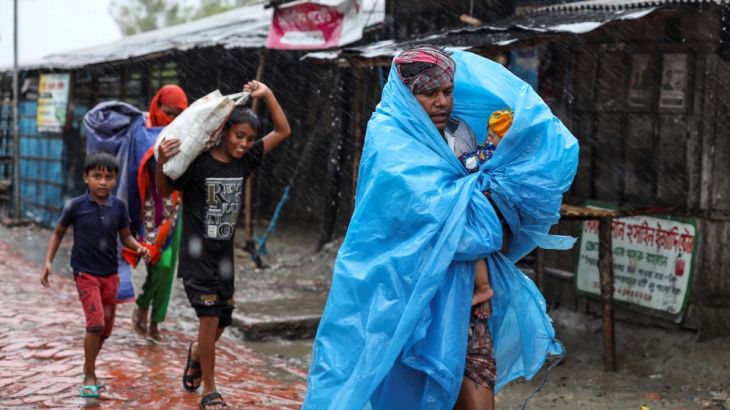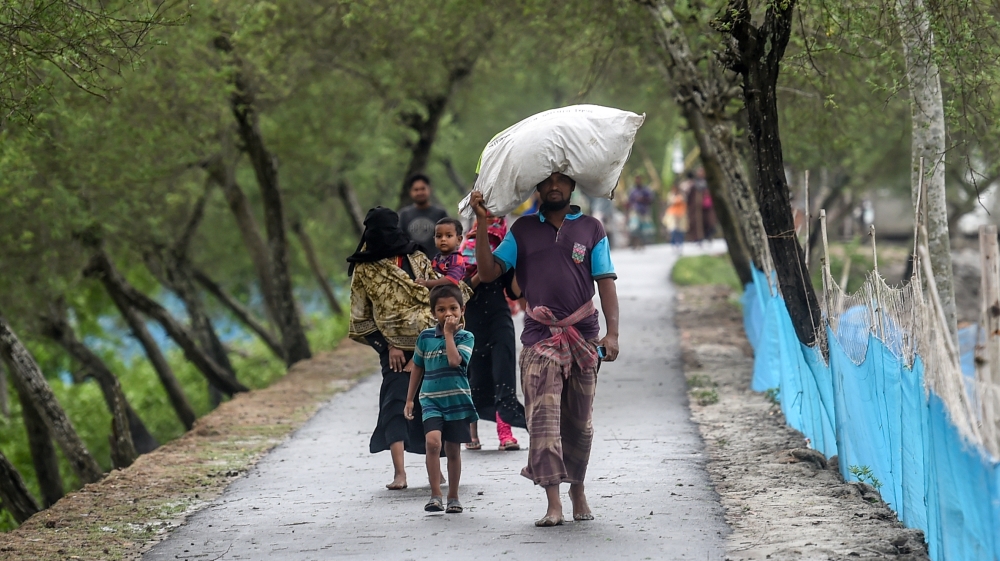Many killed as Cyclone Amphan tears into India, Bangladesh coasts
Strongest cyclone in decades slams South Asian nations, killing at least 14 people and leaving a trail of destruction.

A powerful cyclone has pounded eastern India and Bangladesh, killing at least 14 people and destroying thousands of homes, officials said, leaving authorities struggling to mount relief efforts amid a surging coronavirus outbreak.
“The situation is more worrying than the coronavirus pandemic. We don’t know how to handle it,” Mamata Banerjee, chief minister of West Bengal – the worst-hit Indian state – told reporters late on Wednesday.
Keep reading
list of 3 itemsCyclone Vayu poised to hit India as year’s second major storm
Nearly 800,000 evacuated in India before Cyclone Fani
Banerjee said at least 10 people had died in the state, and two districts been completely battered by one of the strongest storms to hit the region in several years, Reuters news agency reported.
“Area after area has been devastated. Communications are disrupted,” she said, adding that although 500,000 people had been evacuated, state authorities had not entirely anticipated the ferocity of the storm.
In West Bengal’s capital city, Kolkata, strong winds upturned cars and felled trees and electricity poles. Parts of the city were plunged into darkness.
In neighbouring Bangladesh, at least four people were killed, officials said, with power supplies cut off in some districts.
Authorities there had shifted around 2.4 million people to more than 15,000 storm shelters this week.
Bangladeshi officials also said they had moved hundreds of Rohingya refugees from Myanmar, living on a flood-prone island in the Bay of Bengal, to shelter.
The region, with 58 million people in the two bordering countries, has some of the most vulnerable communities in South Asia: poor fishing communities in the Sunderbans and over a million Rohingya refugees living in crowded camps in Cox’s Bazar in Bangladesh.

‘Everything is destroyed’
Houses “look like they have been run over by a bulldozer,” said Babul Mondal, 35, a villager on the edge of the Sunderbans, a vast mangrove forest area home to India’s biggest tiger population.
“Everything is destroyed.”
The trail of devastating of #CycloneAmphan in Kolkata. Trees toppled and fell on electricity transformers causing a scary situation. Power outages have been reported from many parts of the city pic.twitter.com/3uQ22A8Ssd
— NDTV (@ndtv) May 20, 2020
Cyclone Amphan began moving inland with winds gusting up to 185kph (119 miles an hour), Mrutyunjay Mohapatra, director general of the India Meteorological Department, told reporters.
Mohapatra said the storm surge could rise to around five metres in the Sundarbans delta, home to around four million people.
“Our estimate is that some areas 10-15 kilometres from the coast could be inundated,” Mohapatra said.
Coconut trees swayed wildly, electric poles lay scattered on the roads of Kolkata, rain pounded fishing villages, and rivers surged as the storm battered the coast.

‘Next 24 hours crucial’
“The next 24 hours are very crucial. This is a long haul,” said Mohapatra.
Al Jazeera’s Tanvir Chowdhury, reporting from Bangladesh’s capital Dhaka, said the storm is crossing into the country’s southwestern coastal region, hitting the Sundarbans forest adjoining India.
“We have got reports from some of our contacts in those areas saying water level is rising in the low delta areas. A lot of houses have been washed away,” he said.
“We will know the effect of the storm probably by tomorrow… Power lines are going to snap.”
West Bengal: Streets in Kolkata waterlogged, trees uprooted and houses damaged due to strong winds and heavy rain as #Amphan crossed West Bengal-Bangladesh coast between Digha (West Bengal) and Hatiya Islands (Bangladesh) across Sunderbans, between 1530 and 1730 hrs today. pic.twitter.com/obYlwiW9TO
— ANI (@ANI) May 20, 2020
Amphan is the first “super cyclone” to form over the Bay of Bengal since 1999.
The Indian weather department forecast a storm surge of 10 to 16-foot (3-4 metre) waves – as high as a two-storey house – that could swamp mud dwellings along the coast, uproot communication towers and inundate roads and railway tracks.
There will be extensive damage to standing crops and plantations in the states of West Bengal and Odisha, the weather service said in a bulletin.
Authorities were hastily repurposing quarantine facilities for the looming cyclone soon after easing the world’s biggest lockdown against the coronavirus.
India has reported more than 100,000 cases with 3,163 deaths.
